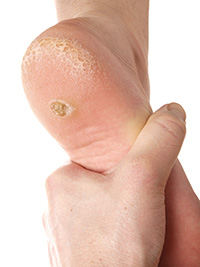Verrucae are warts that occur on the feet. They are caused by the human papilloma virus (HPV) and there are many different strains. They may occur as single or multiple growths affecting the feet (and hands). Verrucae are one of the most common infections of the skin.
Sweaty feet may predispose you more to a verruca as the skin is softer and the PH (acidity/ alkalinity) level of the surface skin is altered. However, it is not fully understood why some people are more susceptible than others.
The latest research suggests that the HPV that causes verrucae lives on our skin in harmony with other bacteria and virus strains and that a lowering of our immune system with mild illness such as colds; flu; stress or poor diet, can allow the virus to take up residence. This has lead us to understand more easily why they can heal themselves and vanish when the immune system is ready to recognise the virus and destroy it.
The thinking that they may be caught by cross-infection from communal floor areas such as swimming pools and showers has fallen out of favour however; any lesion on the foot such as a blister or cut might increase the chances of infection as they provide an easier entry point for the virus.
Verrucae are harmless but can be uncomfortable and painful if they develop on a weight bearing part of the foot. In addition, callus can form over the top of the verruca increasing the discomfort in this area. There are also some strains of the virus that spread very quickly and can look unsightly.
People often worry about passing verrucae onto other members of their family but it is very unlikely, as previously explained HPV is everywhere and you are most likely to catch them because of a dip in your immune system rather than sharing showers or because the sufferer has walked around barefoot.
The most common appearance is that of a small cauliflower type growth on the soles of your feet with tiny black dots. If when you pinch the area (like when you squeeze a spot) it is painful but not with direct pressure, you are likely to have a verruca. They can grow to half an inch in diameter and may spread into a cluster of small warts. If you are unsure, seek advice from your local pharmacist or visit a podiatrist.
In many cases, evidence suggests that verrucae will disappear of their own accord within 18 months for children and 2 to 3 years for adults. This is because eventually the body’s immune system recognises the presence of the virus and fights the infection naturally. HPV is a very clever virus infecting the skin cells as they are produced and it releases tiny protein markers that are anti-inflammatory so that the body’s immune system doesn’t always recognise that it’s there.
Treatment is recommended if:
In the first instance, avoid touching or scratching it as it may spread into a cluster of warts. Instead, cover it up with a plaster Sometimes, rubbing away the dry skin over a verruca and applying a plaster helps to stimulate the body’s immune system to fight the infection.
You can self-treat using ointments and gels from your local pharmacist following the instructions carefully. Evidence suggests the most effective ones contain salicylic acid which when applied to the wart, helps to disintegrate the viral cells.
However, if your verruca becomes unusually painful or the surrounding skin area goes red, stop treatment immediately and see a podiatrist. This is because if the healthy tissue around a verruca is damaged, you could hamper further treatment
Treatments provided by a podiatrist involve an assessment of your general well-being and foot health before deciding on a treatment plan. At Brightwell Clinic we offer the latest and most effective treatment.
Swift Emblation microwave therapy. This is a brand new technology which uses microwave energy, delivered through a special probe to treat the affected tissue. It works by rapidly raising the tissue temperature and creates precise, localised cell destruction. Heat shock proteins are released which are thought to stimulate the body’s immune response aiding the resolution of the verrucae.
Brightwell Clinic does not recommend these treatments under 11 years of age except in exceptional circumstances as children’s immune system will usually resolve a verrucae within 18months.
In these instances you should seek the help of a HCPC registered podiatrist. Additionally, if you have diabetes, poor circulation, are pregnant or any other condition affecting your feet (or your immune system), it is important never to treat verrucae yourself and visit a podiatrist instead. Always ensure that any practitioners you visit are registered with the Health and Care Professionals Council (HCPC) and describe themselves as a podiatrist (or chiropodist).
A Verrucae and a corn are two entirely different conditions, arising from completely different causes and the treatments are also completely different.
A Corn is caused by localised friction, heat and pressure.
A Verrucae is caused by the HP virus.
A corn is clear or yellowish and solid and almost always appears surrounded by areas of hard skin. Corns can occur anywhere, between the toes, on top of toes, under feet and heels. They are usually in an area where there is pressure and friction. Corns are usually about the size of grain of rice. Usually on one pressure point.
